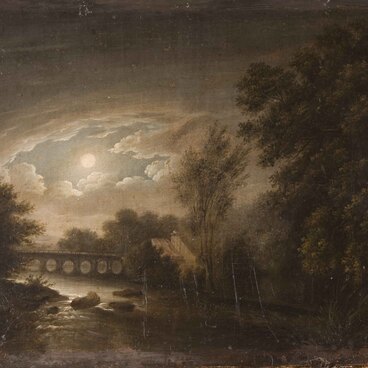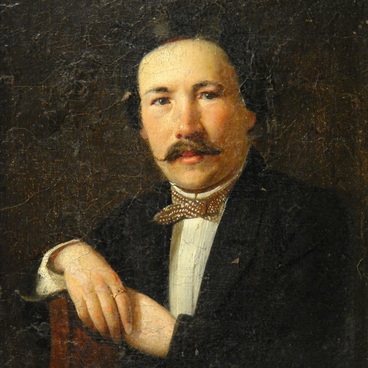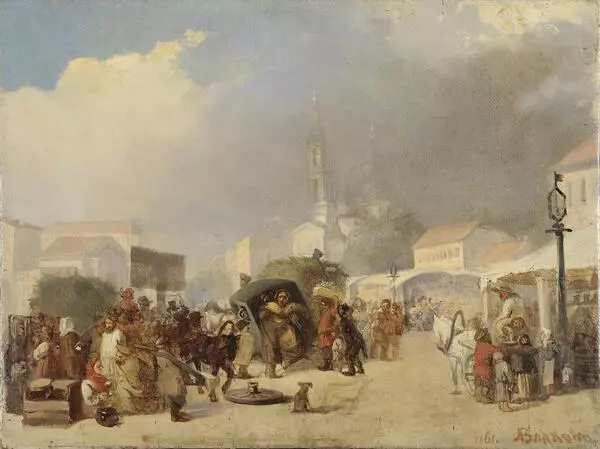The landscape ‘The Rapids’ of 1845 is a painting by the painter Adrian Volkov, best known for his genre paintings ‘The Gluttonous Row in St. Petersburg’ and ‘The Interrupted Betrothal’. He was a volunteer at the Imperial Academy of Arts with Fyodor Bruni in the class of historical painting, but later he was assigned to the class for folk scene painting. He also created paintings on biblical and mythological themes.
His creative development was during a period of growing popular discontent with a low standard of living, defeat in the Crimean War, and inconclusive measures to abolish serfdom. At the same time, the realism trend arose in Russian painting, reflecting without embellishment the vices of society, the hardships of poverty, the suffering of the sick, the loneliness and lack of money in lives of the widows, the greed of unequal marriages. It is his values that are embodied by the famous paintings by Volkov.
Being a prominent representative of the ‘artists of the sixties’, the artist was also engaged in publishing activities in the magazine ‘Malyar’, was the author of cartoons for the magazine ‘Iskra’, created graphic parodies of contemporary literary novelties. His pictorial heritage is presented in large national museum collections: the State Tretyakov Gallery, the Russian Museum, the Pushkin Museum ‘A.S. Pushkin’, and others.
Landscape ‘The Rapids’ from the collection of the Tarusa Art Gallery reflects the influence of the principles of European landscape on the artist through the prism of the work of the famous Russian master of romanticism Sylvester Shchedrin. The composition is simpler and more natural, without stylization; there is no symmetry inherent in classicism.
The period of the 1830s-1850s in Russian painting was defined as the ‘second wave of romanticism’, which was characterized by a reconciliation of classicist and romantic principles. The artist seeks to convey nature in its natural manifestation, but some inaccuracies in its interpretation are obvious - a conditional reproduction of the flow of water and distant plans with a view of architectural buildings, a graphic image of trees. At the same time, warm colors of colors, figures of a shepherd and animals visible in the distance, enliven the romantic landscape and bring a sense of completeness to it.
His creative development was during a period of growing popular discontent with a low standard of living, defeat in the Crimean War, and inconclusive measures to abolish serfdom. At the same time, the realism trend arose in Russian painting, reflecting without embellishment the vices of society, the hardships of poverty, the suffering of the sick, the loneliness and lack of money in lives of the widows, the greed of unequal marriages. It is his values that are embodied by the famous paintings by Volkov.
Being a prominent representative of the ‘artists of the sixties’, the artist was also engaged in publishing activities in the magazine ‘Malyar’, was the author of cartoons for the magazine ‘Iskra’, created graphic parodies of contemporary literary novelties. His pictorial heritage is presented in large national museum collections: the State Tretyakov Gallery, the Russian Museum, the Pushkin Museum ‘A.S. Pushkin’, and others.
Landscape ‘The Rapids’ from the collection of the Tarusa Art Gallery reflects the influence of the principles of European landscape on the artist through the prism of the work of the famous Russian master of romanticism Sylvester Shchedrin. The composition is simpler and more natural, without stylization; there is no symmetry inherent in classicism.
The period of the 1830s-1850s in Russian painting was defined as the ‘second wave of romanticism’, which was characterized by a reconciliation of classicist and romantic principles. The artist seeks to convey nature in its natural manifestation, but some inaccuracies in its interpretation are obvious - a conditional reproduction of the flow of water and distant plans with a view of architectural buildings, a graphic image of trees. At the same time, warm colors of colors, figures of a shepherd and animals visible in the distance, enliven the romantic landscape and bring a sense of completeness to it.





